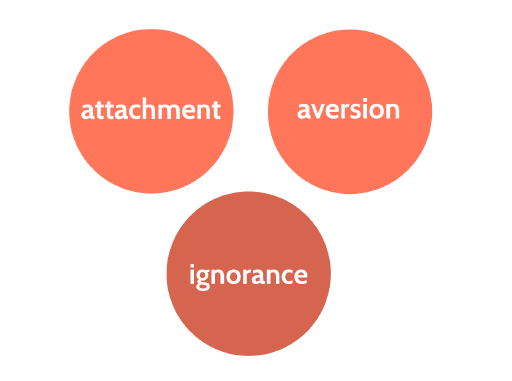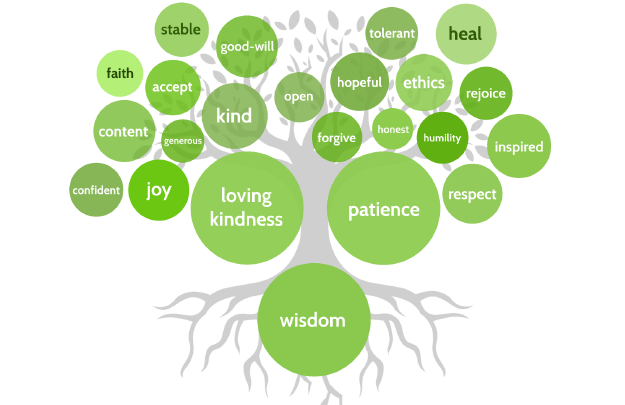Tushita Mediation Centre
Introduction
Tushita is a centre for the study and practice of Buddhism (Mahayana Tradition). I was eyeing this place for a while, with a deep sense of curiosity and a desire to learn more about meditation. I initially heard about them through their YouTube channel. Eventually, I had the opportunity to attend one of their courses, “Introduction to Buddhism”, which left such a big impression on me that I decided to stay for a second one, “Transforming the Mind: The 7-Point Mind Training”.
Location
The centre is located in McLeod Ganj, Dharamshala, India. The name literally translates to “Place of Joy”, which can definitely be the case if you’re into meditation. At the foothills of the Himalayas, it is surrounded by forests and monkeys, while still being easily accessible from McLeod Ganj. Mind you, the whole area is quite hilly, so be prepared for a little exercise if you’re looking to get there on foot. On clear days you can see the snow-capped mountains in the distance, and the sunsets are just breathtaking - they have amazing sunsets at Tushita (I mean, in India, generally). Perhaps it’s the “no phones” policy which makes you appreciate the beauty of nature even more.
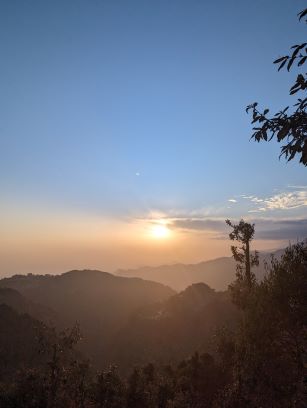
Culturally, the whole area is a mix of Indian and Tibetan influences, with lots of monks and nuns walking around. The
Dalai Lama’s temple is close by in Dharamshala. Just near Tushita, there’s a Goenka Vipassana centre, whose gong can
be heard throughout McLeod Ganj. There are lots of shops and restaurants around, geared towards both Indian and foreign
tourists. Most probably you’ll find something to your liking.
The main gompa (meditation/lecture hall) can hold a bit over 100 people, and it’s quite cozy. Their sound system is
pretty good, and the acoustics are great. Apart from that, there’s a library and several other meditation places around the
centre.
| Main Gompa | Meditation Hall |
|---|---|
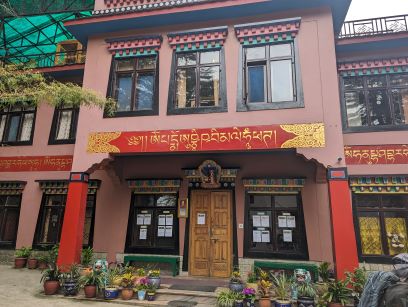 |
 |
There’s plenty of space to stroll around, with benches and tables scattered around the area. There’s also a main stupa, which you may find interesting to walk around.
| Courtyard | Stupa |
|---|---|
 |
 |
Finally, there’s lots of monkeys around, so be careful with your belongings. Also, they can get quite aggressive, so you may want to avoid eye contact or smiling (eg. showing your teeth) at them. Don’t try to pet the baby monkeys, as their mothers can be very protective. The staff at Tushita will give you a briefing on how to behave around them, and they’ll urge you to keep your doors and windows closed, as the monkeys can get inside the rooms and make a mess. Most importantly, don’t feed them. I know they’re cute, but think about the consequences. You’re going to be there for a short while, whereas all the monks and nuns living in the area have to deal with them on a daily basis.
Registration
For registration, I followed the instructions on their website. It was pretty basic, I just had to complete a form and got my confirmation by email in a few days time. Needless to say, you’ll need an Indian visa if you’re coming from abroad. During the peak season (June to October), it’s a good idea to book in advance, as the courses fill up quickly. Don’t place your hopes on a last-minute registration, as you might be disappointed. Even if you happen to show up, and you’re lucky enough to get a spot, you’ll still need to go through the registration process, so might as well do it online. Note that they have a “no phones” policy, so make sure to leave your phone (or other gadgets) at the reception when you arrive - you’ll get it back at the end of the course. Trust me, it’s for the benefit of you and everybody else.
Transport
My plane arrived in Delhi. From there, you have a couple of options to get to McLeod Ganj: by bus, train or plane. I have experienced the train (while going) and the plane (getting back).
Train
Upon arrival, I booked a hotel in Paharganj, which is close to the New Delhi Railway Station, so catching the train was no big deal. If you plan on taking the train, make sure to leave enough time to get to the station, as the traffic in Delhi can be quite heavy. I took the Malwa Express to Pathankot, and from there I took a (per-booked) taxi to McLeod Ganj. The train ride was quite an experience, but it took a long time (around 10 hours) and arrived with a 3-hour delay. The taxi ride was another 3 hours, so I arrived in McLeod Ganj quite tired. The train was comfortable though, not too crowded, and I managed to get a tiny bit of sleep.
Plane
The closest airport to McLeod Ganj is Kangra-Gaggal Airport (Dharamshala). I boarded a plane from Dharamshala to Delhi, operated by IndiGo. This took about 1 hour, and it was pretty much hassle-free. A 15-minute delay due to air traffic in Delhi, but that was it. This option is definitely more expensive than the train, but it’s faster and more comfortable. If I were to go again, I’d probably choose the plane.
Accommodation
The accommodation you’ll get at Tushita is pretty basic (they’ll even joke at the reception that “it is not the beach of Goa”). It varies from dormitories to single rooms, and elderly people get priority for the single rooms (for obvious reasons), then everybody else gets to choose, according to the order of registration (first come, first served). Both times, I stayed in the big dormitory (6-8 people), which was fine for me. There is hot water available for the showers (through a boiler), and some of the toilets are western-style. Overall, you’ll find the place surprisingly clean and well maintained.
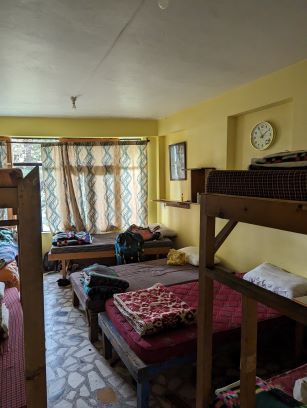
You might want to bring a sleeping bag with you - I was glad I had mine, as it can get quite cold at night. Bear in mind
that you’ll be staying up in the Himalayas, not in the plains of India. You might be able to rent an additional blanket
at the reception, but don’t count on that.
The food is vegetarian (more geared towards vegan). Expect nothing fancy - you’ll get three meals per day, where you can have
as much as you want. Their peanut butter tastes very good, but make sure not to overdo it (can be tempting) - it’s made from
blended peanuts mixed with vegetable oil and salt. Combined with bread, that can be a heavy combo.
Note that they only provide accommodation for the duration of the course, so if you plan on staying longer, you’ll need to find
another place. It is not possible to stay as a tourist at Tushita, and they are quite strict about that.
Courses
Both courses I attended were led by Venerable Thubten Wangdu, an Austrian monk who has been involved in the study and practice of Tibetan Buddhism since 2012. His presentations are jaw-dropping, and he has a great sense of humor. I have attended “Introduction to Buddhism” on March 19-28, 2024, and “Transforming the Mind: The 7-Point Mind Training” on April 3-11, 2024.
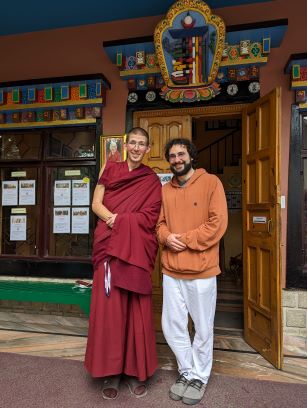
Introduction to Buddhism
This course was a 10-day introduction to Buddhism, which covered the basics of the Mahayana philosophy, supported by meditation sessions. The course takes place within a silent retreat environment - that’s right, you’re not going to talk to anybody for 10 days, nor will you be using your phone. There are a few exceptions to the “no talking” rule, such as the Q&A sessions after each lecture, and the discussion groups which take place from day 2 to day 7, for 1 hour in the afternoon. You’ll be talking about the course material, so it’s not like you’re going to discuss the weather or the latest movie. But don’t worry, there’s a picnic lunch on the last day, where you can finally get to know your fellow meditators.
Prerequisites
There are no prerequisites for this course. However, if you get bored on the plane or train, it could be fun to read a bit
ahead, just to get accustomed to the terminology. I have read “What in Brief Is Buddhism?” by Ananda W.P. Guruge, which
was a good introduction to the subject, and it helped me understand the differences between Theravada and Mahayana Buddhism.
I also had with me the “Essence of Buddhism” by Venerable Master Hsing Yun, which is a very small pocket book that pretty
much summarizes the entire course. Anyway, there’s nothing to worry about, as the course is designed in such a way that
everything comes clearly during the lectures. Seriously, I thought I could give good presentations, but watching Ven. Wangdu in
action was a very humbling experience.
Regarding meditation, if you’ve never meditated before, you might want to try it
out a bit before coming to the course. While it’s not mandatory, it can help you get accustomed to the practice. Sitting
for 45 minutes in silence is not as easy as it seems, but it can be a very rewarding experience.
Schedule
The first day was introductory. From days 2 to 7, you’ll get two lectures per day, three guided meditation sessions, a bit of Karma Yoga in the afternoon, a discussion group and a well deserved break to stretch a little and relax. Days 8 and 9 are intensive meditation days, where on top of the 3 guided meditation sessions, the lectures are replaced by another batch of guided meditations. To be honest, I found the lack of physical activity bit hard on the body, but looking back I think it was not that big of a deal. Just take it as a time to rest and recover, and you’ll get back in shape once you get back home, don’t worry.
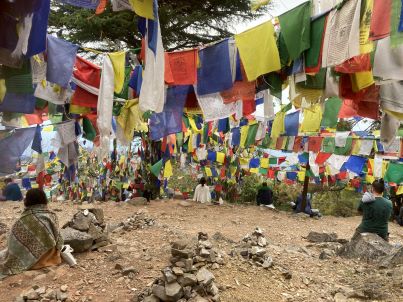
If the weather permits, they’ll take you on a little hike up to a stupa located outside the centre, on the road leading to Galu Temple (while maintaining the silence). The place if full of prayer flags, which are believed to spread positive energy as they flutter in the wind. Monks living in the area often spend several years in retreat, embracing a minimalist lifestyle devoid of modern comforts like hot water or electricity. You can read more about the schedule on tushita.info.
Lectures
I can’t summarize the entire course here, but I can tell you that it was a very enriching experience. I’ll try to give you a glimpse of the most interesting ideas that I’ve written down in my notebook.
The course starts by introducing two types of meditation:
- stabilizing meditation: developing our attention
- analytical meditation: developing our insight and positive qualities
We got to practice both throughout the course. The meditation sessions were led by Manuela, whose experience and dedication to the practice could be felt by everybody. There was patience and understanding in her voice, as she was always with a big smile on her face, ready to answer any questions.
When we talked about the mind, it was defined as “that which is clear and knowing” (like fire is that which is hot and burning). They said the mind has no beginning, no end, and it does not originate from our birth. Every moment of consciousness comes from a former moment of consciousness, and the first moment of consciousness in this life comes from the last moment of consciousness from the past life. This is a very interesting concept, and we explored it in depth during the course. According to Buddhism, each of us have an individual stream of consciousness. There is not one source from which we emerge and then go back to (such as Brahman in Hinduism).
We also talked a lot about the way we perceive reality, and how our mind creates our world. I wrote down one of my favorite quotes from the course:
How others appear to you depends on your mind, not theirs.
Another interesting topic that we discussed during the course was about aversion and attachment. Attachment arises when we exaggerate the positive qualities of an object. For example, we buy a new smartphone, which we then believe to be the cause of our happiness. It obviously doesn’t match with reality, and sooner or later this attachment will lead to suffering. On the other hand, when attachment is not fulfilled, aversion arises. That is, seeing an object as the cause of our suffering and unhappiness. In some cases, aversion can even generate the will to harm. We talked about ways to overcome these two, and how to cultivate a more balanced mind. Here’s in brief, how to overcome anger:
- Understand the harmful nature of anger.
- Become aware of anger in your daily life.
- Notice the anger, acknowledge it, but do not release it nor suppress it. Deal with it in the mind first, taking care of the emotion.
At first, we react instinctively, then we learn how to stop and observe the emotion. From there, we can choose a new response. With practice, it becomes our new habit.
We learned that attachment and aversion stem from ignorance, as ignorance is the root of all suffering. All other negative emotions arise from these two.
The antidote is wisdom, which is the realization of the true nature of reality. From wisdom comes patience and loving kindness.
Your current existence, as you know it now, is going to end. That is the truth. In, say 120 years from now, every human being that lives in this very moment is going to be taken away by death. We have no control over that. Our time is limited. You should use it to be best of your ability, ultimately avoiding any activities that give no one nothing in return, let alone something you find displeasing or worthless. The body that you identify yourself with is going to get old and eventually become unusable. It is only the mind that crosses over to the next life. However, you are never going to get again exactly this combination of body and mind, which you call “I”. Make the best out of this opportunity.
We are often too concerned with what’s going to happen in a non-existent future. Some people are living for a mere projection.
Remember kindness. Every person you know has been once a stranger to you. In Buddhism, they even go one step further and say that every person you know has been your mother in a past life. They have taken care of you, fed you, and protected you. Even in this life, all your abilities were given to you by others. Everything you know at this moment is because someone made that knowledge available to you.
You are the “I” only to yourself, for everybody else you are the “other”.
However, don’t confuse kindness with being docile. To say “no” is not a non-compassionate act.
One other interesting aspect on the nature of reality is that everything was described as a dependent arising. That is, everything arises in dependence on causes and conditions (when different factors come together). Nothing exists independently.

If the beauty would be in the flower the way it appears to you, then everybody would see it the same way (as beautiful). The is not the case, as some may find it ugly. Beauty comes from the mind, not from the object. The same goes for happiness, sadness, and all other emotions. They are not in the object, they are in the mind.

Karma is one of the most fundamental teachings of Buddhism. In Sanskrit, the word means “action”. Karma can be generated by one’s body, speech or mind. When we perform wholesome or unwholesome actions, they are stored as karmic seed within our consciousness. When the right conditions are present, these karmic seeds will generate karmic effects. All karma will eventually ripen and produce karmic effects, it is just a matter of time. This is not a reward nor a punishment, it is a law of the universe, just like gravity.
Nothing is permanent, everything is subject to change.
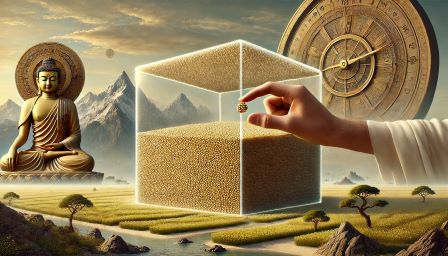
The concept of time and space was also discussed, although not in such great detail as I would have liked. In Buddhism,
a very long unit of time is called a kalpa. The length of time represented by a kalpa is simply mind-bending. Imagine a huge
container measuring 10 kilometers in each direction - that’s basically a cube with the volume of 1000 km3.
Now, fill that container with fine mustard seeds, and take one seed out every 100 years. The time it would take to empty
the container is the length of one minor kalpa. Human beings typically live for about 100 years; some insects are born
at down and are dead by dusk. To such an insect, one day is the equivalent of one hundred years in human terms. Although
there is a huge difference between one day and one hundred years, each existence spans a lifetime. According to Buddhism,
there are beings with far longer life spans then human beings, stretching our imagination even further. Beyond the heavens
of the form realm, there are the formless realms. Beings in this realm can live up to 80000 major kalpas. The duration
of such a life span is incomprehensible.
Regardless of how long these beings live, they are still subject to the law of impermanence, trapped in the cycle of
birth and death. They still cannot transcend the boundaries of time and space.
However, OpenAI’s DALL-E model does a pretty good job when it comes to illustrating this subject:

We touched upon lots of other topics, such as the 4 Noble Truths, the 8-fold Path, the 6 Perfections, the Wheel of Life, Bodhicitta, and so on. I can’t cover everything here, but I hope I’ve given you a taste of what to expect.
Meditations
Pretty much every meditation session has given me something. I remember the meditations on “Death Awareness” and
“Forgiveness” were quite impactful for most of the group. During the “Karma Purification” session I felt a strong
vibration while chanting the mantra “Tayatha Om Mune Mune, Mahamunaye Soha” and visualizing the Buddha. I felt really
tired after that, but in a good way. The “Loving Kindness” meditation was quite moving, as we were asked to
visualize a person we love, then a person we have neutral feelings towards, then a person we have difficulties with,
and finally all sentient beings. The idea is to cultivate a feeling of love towards all beings, regardless of their
relationship with you. We also did a “Tonglen” mediation, which is a very powerful Tibetan Buddhist meditation practice
for cultivating compassion. And, I would like to highlight one of my favorites, when one evening we circled the main
stupa outside and changed “Om Mani Padme Hum” for like two hours. I am deeply grateful towards everybody which took part
that 🙏.
All in all, I encourage you to attend, you’ll be in for quite a ride. Don’t worry that much about sitting cross-legged
for hours, as they have plenty of chairs available.
Transforming the Mind: The 7-Point Mind Training
This was a 9-day intermediate course, which followed a similar structure to the previous one. The course was designed
to build upon the knowledge gained during the “Introduction to Buddhism” course, and to deepen the understanding of
Lojong (mind training) practices. We studied the writings of Chekawa Yeshe Dorje (1101-1175), a Tibetan Buddhist master
who compiled the Seven-Point Mind Training. It is one of the earliest works organising the Lojong teachings into a
systematic framework. In order to follow this course, you should have completed the “Introduction to Buddhism” course in
one of the FPMT centres who offer it, such as Tushita or
Kopan Monastery.
I unfortunately felt sick during the course, and while I still attended 90% of the lectures and meditations,
I did not take as many notes as I did during the first course. So I won’t go into as much detail as I did with the
previous one, but I can tell you that this was a very enriching experience too. In between the teachings, I remember
Ven. Wangdu always telling us about how bad the “spiritual ego” can be, and how we should be careful not to fall into that trap.
That’s basically when we start to think we’re better than others because we’re more spiritual, and we show off our
knowledge or our new mala beads.
Our good qualities cannot grow on the rocky peaks of pride.
Other Activities
If you plan on attending a silent retreat, you might want to take a few days off after the course to relax and slowly re-adjust to the “outside” world. Flying back to Delhi right after such an experience can be tiring. Also, the area around McLeod Ganj is very beautiful, it’s definitely worth exploring it if you have some extra time.
Jagatram Niwas
Outside the meditation centre, I stayed at Jagatram Niwas, a guest house located in Upper
Bhagsu, right next to McLeod Ganj. It is way more silent and peaceful than McLeod Ganj, while still being close to all
the cafes and restaurants. Depending on your pace, it’s a 10-15 minute walk to the main square, and a 25-30 minute walk
to Tushita (going by car is also possible). The rooms are clean and spacious, and the guest house is run by a very nice family, who are always ready to
help you with anything you need. Whatever I asked for, from car rides to laundry, flexible booking, meals and trekking, they were always
there for me. They really made me feel like an honored guest, and I am very grateful for that. Not to mention, the
delicious home-cooked meals they served me. We had dinner together a few times, and I got to know them better. I was
“adopted” by the sweet grandmother of the house, and they treated me like I was part of the family.
I got along really well with their two sons, Vikas and Vishal. When I found out that Vikas is an official trekking guide, I
immediately booked him, which proved to be one of the best decisions. They didn’t ask me to do so,
and most probably are not even aware that I wrote about their guest house here, but I felt compelled to mention this,
as I see it as such a big part of my journey, having had the chance to experience genuine Himalayan hospitality.
Trekking

I went on a few treks around the area, and the views are just breathtaking. Massive shoutout to my guide, Vikas, who took me off the beaten track to Triund. He arranged a tiny cabin room for me at the top, so I could enjoy the sunset and sunrise from there. If there’s one thing you should do while in McLeod Ganj, it’s definitely going to Triund. His friendly, yet introspective personality perfectly complements the calmness of the mountains. I totally recommend exploring the area with a local guide. It’s a lot safer, hassle-free, you get to learn a lot more about the culture, and you’re helping the local economy.
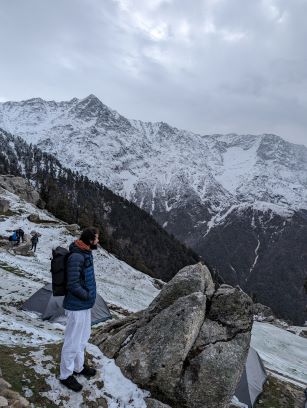
In terms of other activities, Vikas took me to the Kangra Market, Galu Temple, Naddi Village and booked me a paragliding sessions at sunset, in Dharamshala.
Eating Out
Although I don’t consider myself a restaurant guru, I can tell you that the food in McLeod Ganj is quite good. Actually, there’s several places geared more towards tourists, where you can find all sorts of cuisines. You’ll definitely find something to your liking. I enjoyed The Crossover Cafe for reading my book along with a cup of amazing hot chocolate. Also, if you’re into amazing views, and have some extra time to walk around (or a taxi), I recommend going to The Sunset Cafe. Not only the view over the valley is awesome, but in terms of pizza, it’s the best I’ve ever had in India. As close as it gets to a cozy european place.
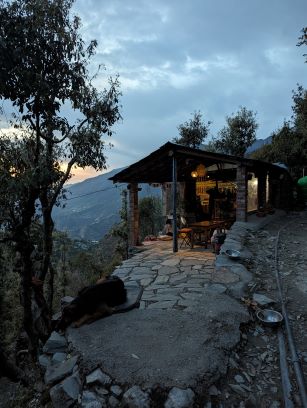
Delhi
While coming back to New Delhi, before leaving, I stayed at Colonel’s Retreat. My favourite place to eat was Aggarwal Restaurant, located in Paharganj, within walking distance from the train station. I met with a couple of my friends and explored the city together. Uttam was so kind (and patient) to let me drive his car, an experience I will never forget. After a yoga class at the Sivananda Yoga Vedanta Nataraja Centre, Krishna took me to the ISKON Temple, where we had a great time together. I also recommend checking out Jama Masjid, one of the largest mosques in India. I went there at prayer time during ramadan, and it’s a sight to be seen.
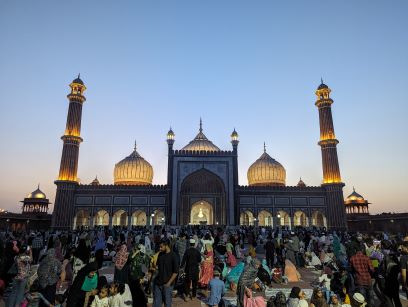
Conclusion
I feel very grateful for having had the opportunity to attend these courses. Not talking to anybody and observing silence for days on end felt weird at first, but I slowly got adjusted to it. However, I think the most interesting aspect was the no-phones policy. I didn’t miss mine (except maybe the camera, for the first two days), but by the end I felt like I was seeing the world through different eyes. I was more present, more aware of my surroundings, and I was getting better rest. I remember the first time I got my phone back, it was of course flooded by emails and notifications. It took me about 1 hour to sort out through everything, after which I started to feel a weird burning sensation in my eyes and chest. I realized that it was being caused by the instant and continuous stimulus the phone was providing (messaging, web browsing, notifications, etc.). If there’s one thing I’m sure of now, is that spending time on our phones can be very tiring and over-stimulating, often without us even realizing it. Tried and tested.
May all beings be happy!
